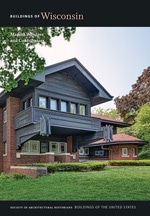
Best known for his innovative buildings, Keck began his career designing period-revival houses, although with indications of the modernism he soon embraced. Not long after he established his architectural practice in Chicago, the Watertown native designed this Tudor Revival house. While at first glance the design seems traditional, on closer examination, we see the beginning of Keck’s subsequent minimalism. He combined historic details—steeply pitched gabled roofs and false half-timbering—with the cubic massing that became the basis of his later work. Brick walls support three intersecting gabled roofs of different heights along an L-shaped plan. Especially interesting is the way that the ends of the rafters butt up to the top plate, eliminating any overhang. Instead of projecting dormers lighting the attic of the ell, recessed dormers with casement sashes puncture the slope of the roof. Even the broad frieze of false half-timbering appears almost more modern than medieval in its geometry.






